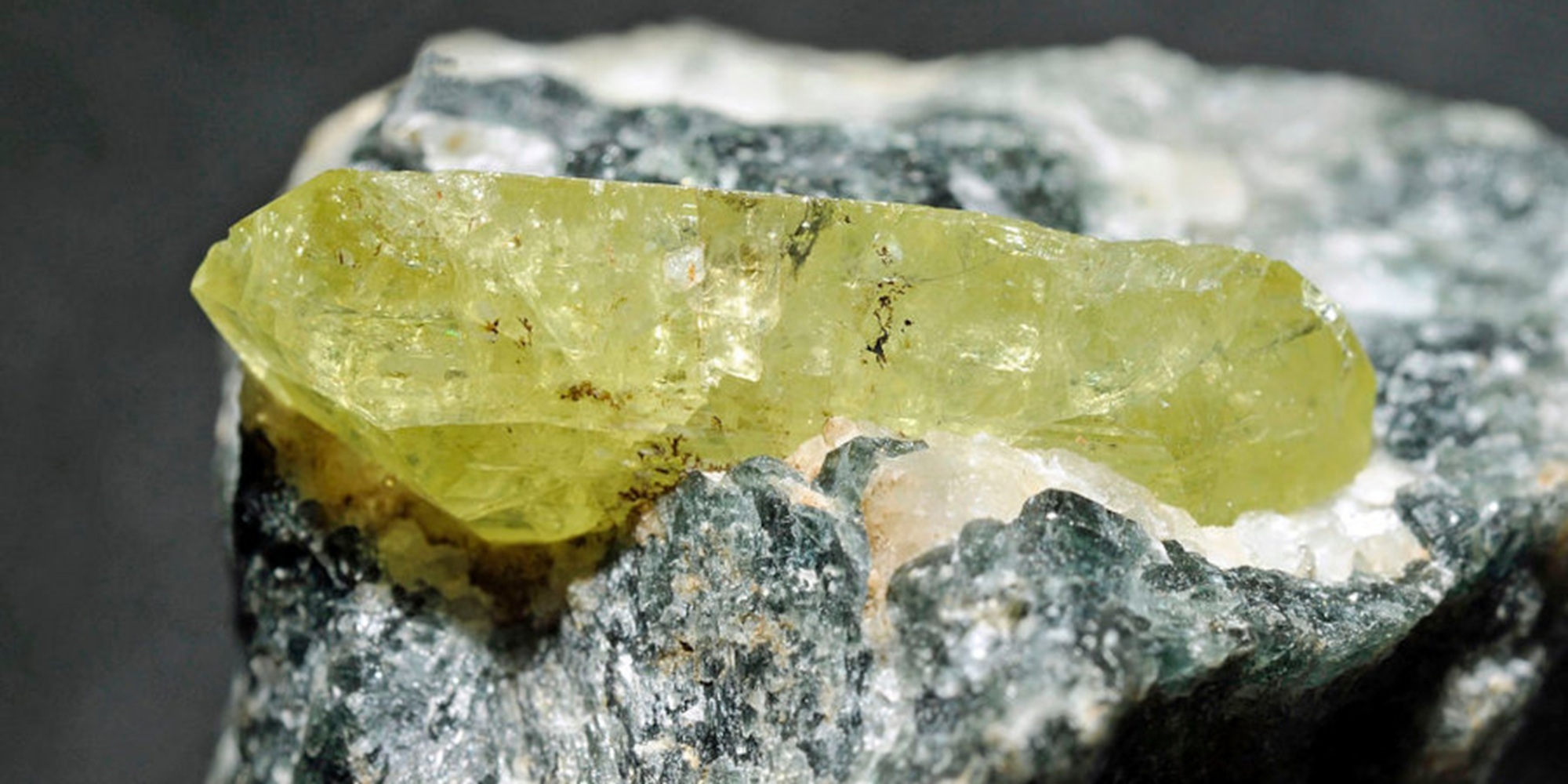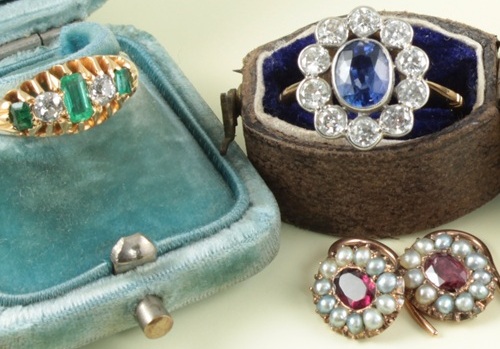Chrysoberyl
The name Chrysoberyl is derived from the Greek words “Chrysos” which means gold and “Beryllos” which means gemstone. Chrysoberyl is a golden to green colour and is normally cut using a Ceylon cut or brilliant cut. The Chrysoberyl mineral group also contains the varieties Alexandrite and Chrysoberyl Cat`s Eye. Both of which are highly prized and much sought after by collectors. Although Chrysoberyl and Beryl have similar names, they are both completely different gemstones, each belonging to a different mineral group.
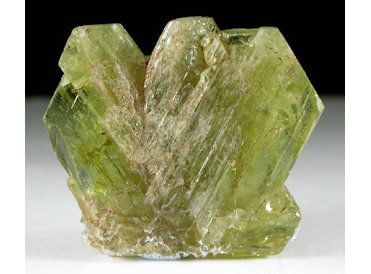 Formation: Chrysoberyl is formed in granite pegmatite and mica schist. As magma cools, beryllium-rich water becomes concentrated and begins to crystallise. The presence of impurities such as iron will result in colours ranging from yellow to light green. If vanadium is present, it will produce a greenish-blue colour. In the case of Alexandrite, chromium is responsible for its colour-changing abilities. Alexandrite is green in daylight and turns red/purple in incandescent light. Chrysoberyl can also form in metamorphic host rock. The intense pressure and high temperature during the metamorphic process will cause the beryllium-rich solution to crystallise. Once Chrysoberyl has formed in the host rock. Prolonged weathering and geological processes can erode the host rock, releasing the gemstone. Which will in time get washed down into riverbeds or flood plains where it will accumulate. These secondary deposits are known as placer deposits. Gemstones found in placer deposits typically have slightly rounded edges when compared to gemstone extracted directly from the host rock. Due to their journey from the host rock to the placer deposit.
Formation: Chrysoberyl is formed in granite pegmatite and mica schist. As magma cools, beryllium-rich water becomes concentrated and begins to crystallise. The presence of impurities such as iron will result in colours ranging from yellow to light green. If vanadium is present, it will produce a greenish-blue colour. In the case of Alexandrite, chromium is responsible for its colour-changing abilities. Alexandrite is green in daylight and turns red/purple in incandescent light. Chrysoberyl can also form in metamorphic host rock. The intense pressure and high temperature during the metamorphic process will cause the beryllium-rich solution to crystallise. Once Chrysoberyl has formed in the host rock. Prolonged weathering and geological processes can erode the host rock, releasing the gemstone. Which will in time get washed down into riverbeds or flood plains where it will accumulate. These secondary deposits are known as placer deposits. Gemstones found in placer deposits typically have slightly rounded edges when compared to gemstone extracted directly from the host rock. Due to their journey from the host rock to the placer deposit.
Treatment: As a general rule, there are no treatments applied to Chrysoberyl. Quality Chrysoberyl is typically transparent, with excellent clarity and rarely contains inclusions. For lower-quality gemstones, heat treatment can be used to improve colour and clarity. Heat treatment can also be used on Alexandrite to enhance its colour-changing ability. Neutron irradiation can also be applied as a treatment, but is rarely done.
Durability: Chrysoberyl has a hardness rating of 8.5 on the Mohs scale. Which makes it ideal for everyday use. This gemstone is extremely hard and durable. With excellent resistance to scratches, chipping or cracking from impacts. Chrysoberyl is considered chemically stable and is not sensitive to sunlight.
Chrysoberyl Cat`s Eye: The term “Cats Eye” always refers to Chrysoberyl, all other gemstones using the name Cats Eye must include the stones name. Cats Eye is also called Cymophane which is derived from the Greek words “waving light”. Cats Eye can range in colour from honey-yellow, which is the most desirable to yellow-green and brown. Cats Eye can on occassion can be clear in colour or mint-green however, these are rare. Cats Eye is formed when fine, parallel inclusions produce a white or silver line within the gemstone resembling the pupil of a cats eye. These inclusions cause the light to move along the white or silver line, an effect known as chatoyancy. Cats Eye is always cut as a cabochon to properly display this feature. Historically, Sri Lanka was the world`s primary source of Cats Eye. Today Brazil is the main producer, other deposits are located in India, China, Zimbabwe and Madagascar.
Alexandrite: This Alexandrite is named after the Russian Czar Alexander II and it was only recently discovered in the early 1830s. It was found in the Ural mountains and quickly became highly prized amongst the aristocracy for its dramatic colour-changing ability. Alexandrite is a green colour when viewed in daylight but turns to red/purple when viewed in incandescent light. Larger and heavier stones display this colour-change most dramatically. In Russia, Alexandrite was associated with the national colours of red and green, the stone was also believed to bring good luck. Alexandrite is an extremely rare gemstone, with quality specimens typically selling for ten times more than diamonds. Making Alexandrite one of the most valuable gemstones on the market. The deposits in the Ural mountains have since been depleted. Today Brazil, Sri Lanks, India, Tanzania and Zimbabwe are the main producers.
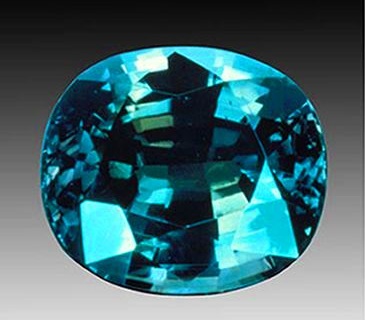
Alexandrite Gemstone in Daylight
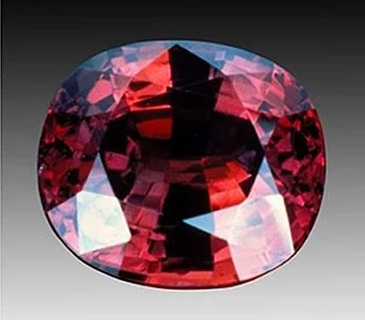
Alexandrite Gemstone in incandescent light
Meaning and Healing Properties
Chrysoberyl symbolises harmony, clarity, patience and endurance. The stone is also associated with good luck, prosperity and increasing the wearers creativity. It is said that the gemstone will work to amplify the properties of other gemstones, when they are worn together. Chrysoberyl is credited with having a number of healing properties. The stone is said to prevent heart attacks or strokes, detoxify the liver, balance hormones, improve eyesight and aid sleep.
Chakra: Chrysoberly is associated with the solar plexus chakra, helping with inner strength and self-confidence. It is also linked with the crown chakra, helping with spiritual enlightenment. The heart chakra, helping with optimism and kindness. The third eye, helping with intuition.
Birthstone: Alexandrite is the birthstone for March, symbolising transformation, good luck and balance. The other two birthstones for March are Pearl and Moonstone.
Zodiac Astrology: In some traditions Chrysoberyl gemstone is associated with the star sign Virgo. Normally, Virgo is associated with Sapphire.
History

The earliest known Chrysoberyl mines were located in Sri Lanka. Particularly in the Ratnapura area, which is located in the Sabaragamuwa province. Gemstone mining here dates back thousands of years, with most mining activities taking place in secondary deposits ( also called placer deposits ). These deposits are typically riverbed gravels or gravel deposits underneath flood plains. Sri Lanka has long been renowned for producing high-quality Chrysoberyl, especially Cat`s Eye. The world`s largest known Cat`s Eye was found in Pelmadulla in the Ratnapura district in the late 1800s. It was discovered in a gravel deposit in a rice field owned by Lady Iddamalgoda Kumarihamy. This uncut Cat`s Eye weighed over 700 carats. Later in 1930, the stone was cut and it produced a 465 carat cabochon and was given the name “The Eye of The Lion”.
In the 17th Century, significant deposits of Chrysoberyl were discovered in the Minas Gerais region of Brazil. Later on in the 18th Century, further discoveries were made in the Espirito Santo region. Exports of the gemstone from Brazil began about 1805 and today Brazil is considered one of the largest producers. Chrysoberyl from Brazil ranges in colour from yellow to yellow-green, dark green and brown. The Minas Gerais region is also a major source of honey-coloured Cat`s Eye and Alexandrite. Alexandrite from this region is typically blue-green in daylight and turns to pink-red in incandescent light.
Alexandrite was discovered in the 1830s in the Ural Mountains in Russia. Named after the Czar Alexander II, Alexandrite found in the Urals was of exceptional quality, clarity and renowned for its dramatic colour-changing. Deposits in the Urals are now largely depleted.
Historically there are no early records to suggest that there was any significant Chrysoberyl mining in ancient India. However, there was historical cultural use of the gemstone in India and it is generally thought that there was small-scale mining from alluvial deposits. Large-scale commercial mining of Chrysoberyl began in the 1980s and 1990s. Today India is a significant producer of the gemstone.
In 1878, Prince Arthur, the Duke of Connaught and Strathearn gave Princess Louise Margaret of Prussia a Chrysoberyl Cat`s Eye ring for their engagement. This publicity made Cat`s Eye extremely popular. So much so that the mines in Sri Lanka could not keep pace with demand.
Folklore
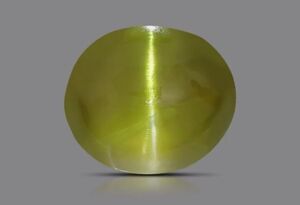 Throughout history, people have associated Chrysoberyl with wealth, protection and good luck. The stone was believed to bring wealth and success, particularly in business. Cat`s Eye gemstone would be given as a gift to someone starting a new business, to bring them good luck and prosperity. For this reason, it was often passed down through family generations. Cat`s Eye was also believed to hold the soul of a cat within it, endowing the wearer with cat like agility along with protection and insight. Cat`s Eye was believed to ward off evil spirits and to protect the wearer from the evil eye.
Throughout history, people have associated Chrysoberyl with wealth, protection and good luck. The stone was believed to bring wealth and success, particularly in business. Cat`s Eye gemstone would be given as a gift to someone starting a new business, to bring them good luck and prosperity. For this reason, it was often passed down through family generations. Cat`s Eye was also believed to hold the soul of a cat within it, endowing the wearer with cat like agility along with protection and insight. Cat`s Eye was believed to ward off evil spirits and to protect the wearer from the evil eye.
In India the gemstone was associated with the planet Ketu and spiritual growth, fostering intuition and spiritual insight. Throughout Asian cultures wearing the gemstone was seen as a symbol of self-control and discipline.
In Arabic culture, the stone was believed to make the wearer invisible and as such was worn by warriors into battle.
Greek/Roman mythology: Chrysoberyl is not directly associated with any Greek or Roman god. In ancient Greece and Rome, the gemstone itself was seen as a source of protection. It was said to ward off curses, misfortune and the evil eye.
Medieval Europe: During the middle-ages, Chrysoberyl symbolised wisdom, good luck and protection. It was also believed to enable the wearer to see in the dark. In Europe at the time, the gemstone was seen as a status symbol worn by royalty and the aristocracy. Its use in medieval Europe was not widespread unlike its use in Asia. So Chrysoberyl`s presence and folklore is largely absent from this period.
Famous Chrysoberyl
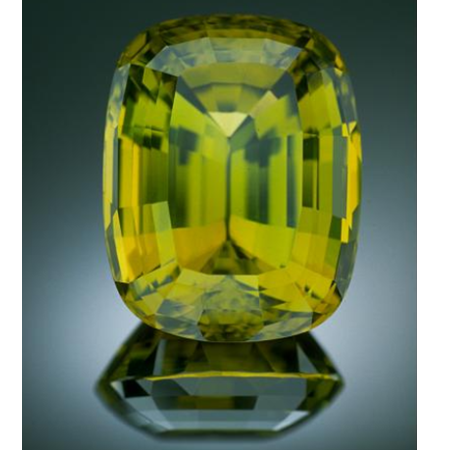
The 114.25-carat Chrysoberyl from Brazil.
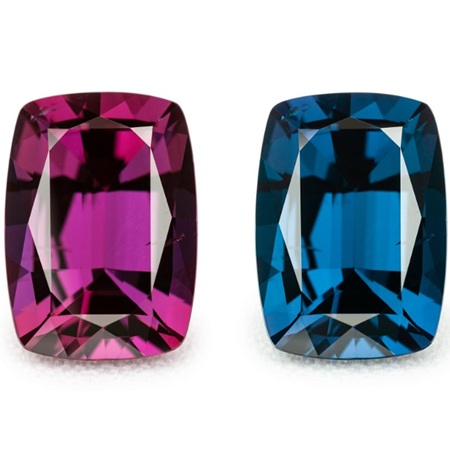
The Whitney Alexandrite.
Chrysoberyl Gemological Data
Colour: Golden-yellow, green-yellow, green, brownish, red.
Colour of Streak: White.
Moh`s hardness: 8.5
Density: 3.70 – 3.78
Cleavage: Good.
Fracture: Weak conchoidal, uneven.
Crystal system: Orthorhombic, intergrown triplets.
Transparency: Transparent to opaque.
Chemical composition: BeAl2O4 beryllium aluminum oxide.
Refractive index: 1.746 – 1.763
Double refraction: +0.007 to +0.011
Pleochroism: Very weak: red to yellow, yellow to light green, green.
Dispersion: 0.015.
Fluorescence: Normally none or weak, green.
For Researchers and Journalists: Citing This Article
Recommended Citation (MLA) Format:
Hoyne, John. “Chrysoberyl, Alexandrite & Cat`s Eye: Meaning and History.” Carus Jewellery, n.d., https://carusjewellery.com/chrysoberyl/.
You can also get in touch with Carusjewellery.com on Facebook , were you may leave any comments or questions you may have about this article.

